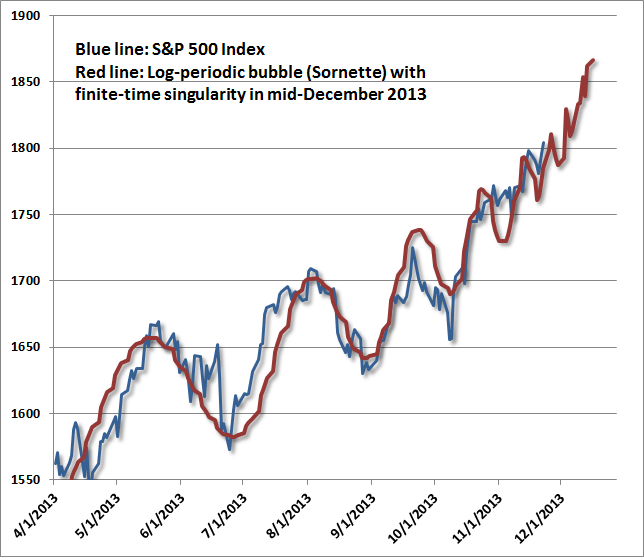The primary drivers of asset prices are the economy and corporate earnings. With that in mind, consider that both are rolling over today.
Indeed, when we take the big picture, we find that corporate profits, as a percentage of GDP are also at all-time highs. Never before in history have corporations made so much money relative to the US economy. This trend is not likely to continue.
Finally, take a look at the massive divergence between nominal GDP and the S&P 500. Economic growth drives earnings, which in turn drive stocks. And as you can see, economic growth has been drifting sharply lower.

Source: the King Report
Detailing precisely when stocks will plunge is very difficult. All we can say with great certainty is that stocks are rallying ever higher on weakening economic fundamentals. This is precisely what happened in the build up to the 2008 Crash.
Indeed, if is now clear stocks are definitively in a bubble. Based simply on CAPE (cyclical adjusted price to earnings) the market is significantly overvalued with a reading of nearly 24 (anything over 15 is overvalued).

Indeed, we’ve only been at this level of valuation during major stock tops (1929, 1966, 2000, and 2007)
Thus we find that:
1) The US economy is in recession again
2) Corporate profits are at record highs and set to fall
3) Stocks are extremely overvalued
All of these add up to a real problem for long-term stock investors today. The classic method of valuing stocks, the P/E ratio is comprised of market cap relative to earnings.
If earnings are at record highs today and stocks are already overvalued, how high will P/Es be when earnings begin to contract with stocks at these levels?
My point with all of this is that based on valuations and economic conditions, now is not the time to be loading up on stocks. There will be plenty of opportunities such as NVDA and NDRO which we’ve already invested in, but overall, I would not be heavily buying stocks at these levels especially relative to earnings.
Speaking of earnings, let us now move to #2 on the list of items I listed at the opening of this issue: the recent collapse in revenues and earnings at economically sensitive firms.
We’ve seen a recent spate of terrible results from corporate America.
In the few quarters we’ve seen disappointing earnings at:
1) Caterpillar (global machinery)
2) Microsoft (software)
3) Google (search engine ad revenue)
4) Chevron and Exxon Mobil (oil)
5) Discovery (credit cards)
6) Amazon (online retail)
7) Charles Schwab (brokers)
8) Wynn Resorts (casino)
There are dozens and I literally mean dozens of ways to craft earnings to be better than reality. You can writedown assets, alter depreciation methods, manipulate bad debt expenses in accounts receivables, game the closure of deals, take one time charges, utilize derivatives and mark to model valuation of assets, etc.
Indeed, a study performed by Duke University found that roughly 20% of publicly traded firms manipulate their earnings to make them appear better than they really are. The folks who were surveyed for this study about this practice were the actual CFOs at the firms themselves.
In this sense, it is safe to assume that recent earnings, as poor, are they are, have been “massaged” to look better than reality.
Indeed, we get confirmation of this from revenues misses. As I mentioned a moment ago, earnings can manipulated any number of ways, but revenues cannot; either money came in or not.
With that in mind, we’ve in the last few quarters we’ve seen revenues misses at:
1) Merck (big pharma)
2) Molson Coors (alcohol)
3) Clorox (cleaning materials)
4) US Steel (steel)
5) McDonald’s (fast food)
6) 3M (conglomerate)
7) GE (conglomerate)
This brings me back to an earlier point, that profits and earnings are likely peaking. All of these point to a top forming.
Be prepared.
For a FREE Special Report on how to beat the market both during bull market and bear market runs, visit us at:
http://phoenixcapitalmarketing.com/special-reports.html
Best Regards
Phoenix Capital Research
![]()
via Zero Hedge http://feedproxy.google.com/~r/zerohedge/feed/~3/RJlrbAj2q4M/story01.htm Phoenix Capital Research





















